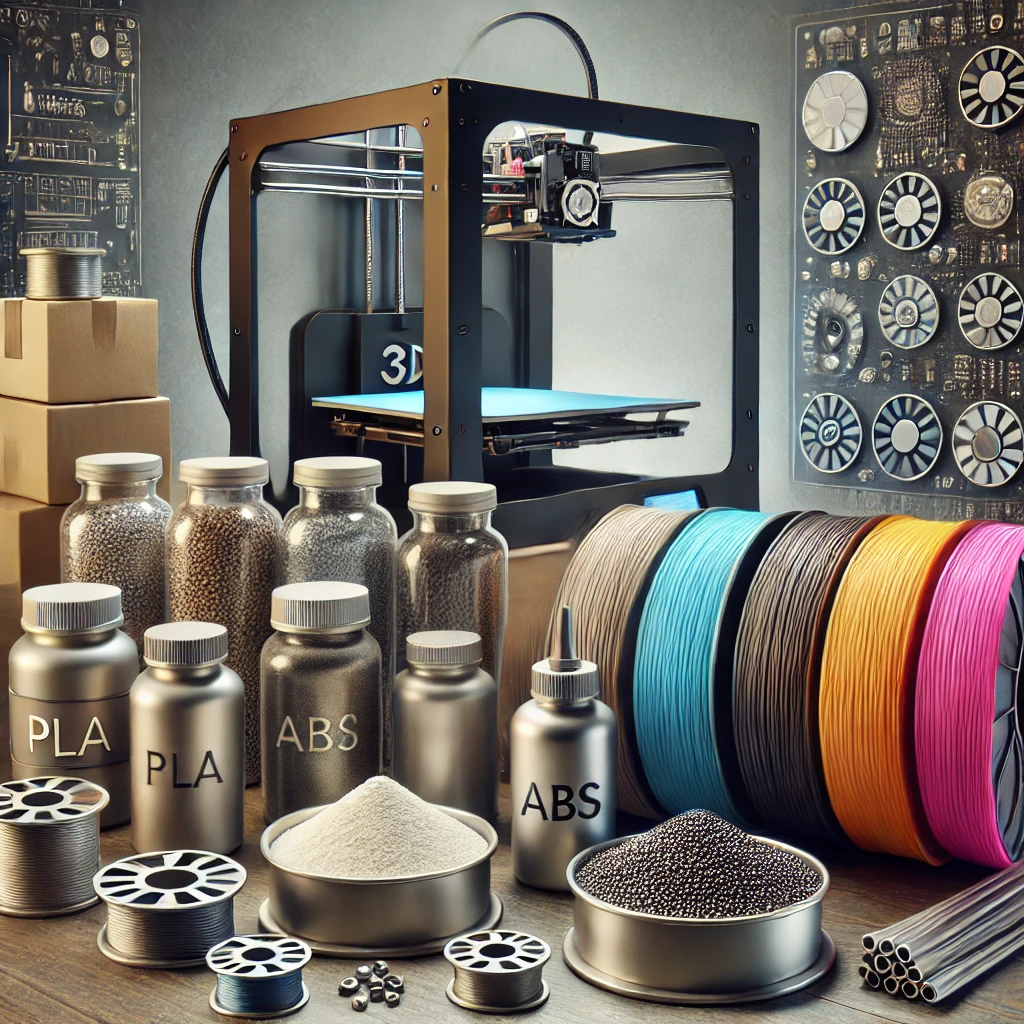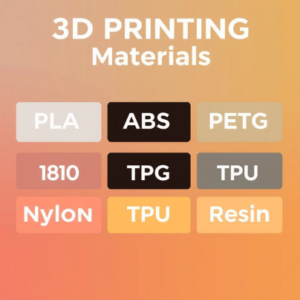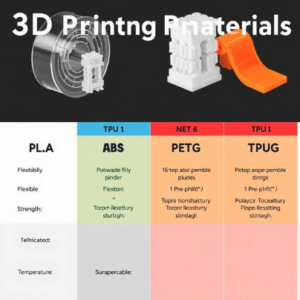
3D printing, also known as additive manufacturing, is an innovative process that creates physical objects from digital designs. Over the past few decades, this technology has revolutionized the way products are designed, prototyped, and manufactured. The core of 3D printing’s success lies in the materials used in the process. From plastics to metals, and even ceramics, the choice of material can influence the outcome of a printed object significantly.
The material you choose for your 3D printing project determines its strength, flexibility, durability, and appearance. In 2024, the variety and sophistication of 3D printing materials have reached new heights, expanding the scope of industries that use this technology—from healthcare to automotive, aerospace, and beyond.
In this guide, we will explore the different materials used in 3D printing, their properties, applications, and the latest trends in the field. Whether you’re a hobbyist, designer, or professional, this article will provide you with a detailed understanding of the material options available for your 3D printing projects.
II. The Evolution of 3D Printing Materials
The journey of 3D printing materials has been a story of innovation, driven by the need for greater functionality, flexibility, and sustainability in manufacturing. Early 3D printing technologies were largely limited to the use of simple plastics and resins. These materials were suitable for creating prototypes and models, but their application was constrained by limitations in strength, precision, and cost-effectiveness.
By the early 2000s, the industry began to experiment with metals, composites, and other specialized materials. This shift allowed for more robust, durable, and versatile products to be printed, paving the way for industries like aerospace, automotive, and healthcare to embrace the technology.
As we move into 2024, 3D printing materials have advanced to include high-performance options like carbon fiber composites, flexible filaments, bioplastics, and even materials for medical applications such as bioprinting. These materials continue to evolve to meet the growing demands of industries, with a focus on enhancing strength, precision, sustainability, and customization.
III. Types of Materials Used in 3D Printing
3D printing materials can be broadly categorized into several types based on their properties and applications. Below, we will explore the most commonly used materials in 3D printing: thermoplastics, metals, ceramics, composites, resins, and biomaterials.
A. Plastics (Thermoplastics)
Plastics remain the most widely used materials in 3D printing. Thermoplastics, in particular, are preferred due to their ability to melt and re-harden, making them easy to work with during the printing process. There are several types of thermoplastics used in 3D printing, each with distinct properties suited for various applications.
-
PLA (Polylactic Acid)
PLA is a biodegradable plastic made from renewable resources like cornstarch and sugarcane. It is the most popular 3D printing filament for beginners due to its low melting point, ease of use, and minimal warping. PLA prints at relatively low temperatures, which reduces the risk of distortion during the printing process. However, PLA is not as strong or heat-resistant as other plastics, making it unsuitable for high-stress applications. -
ABS (Acrylonitrile Butadiene Styrene)
ABS is known for its strength, impact resistance, and durability. It is commonly used for functional prototypes and parts that require mechanical properties like toughness. ABS is more heat-resistant than PLA and can withstand higher temperatures, but it can warp during the printing process. This makes it more difficult to print with compared to PLA. It is widely used in automotive parts, consumer electronics, and toys. -
PETG (Polyethylene Terephthalate Glycol)
PETG combines the ease of PLA with the strength and durability of ABS. It is less prone to warping, making it easier to print with than ABS. PETG is also resistant to moisture and has a smooth, glossy finish, making it ideal for applications where appearance is important, such as in consumer products and packaging. It is strong, flexible, and highly durable, making it suitable for parts that will undergo physical stress. -
TPU (Thermoplastic Polyurethane)
TPU is a flexible, rubber-like material that can stretch and bend without breaking. It is ideal for creating parts that require elasticity, such as phone cases, belts, and footwear. TPU is highly resistant to wear and tear, making it suitable for products that need to withstand abrasion and impact. However, TPU is more challenging to print with due to its flexibility, requiring careful handling during the printing process. -
Nylon
Nylon is a versatile material known for its strength, flexibility, and abrasion resistance. It is often used in the production of functional prototypes, gears, hinges, and other moving parts. Nylon is highly resistant to wear, making it ideal for applications where durability is a concern. However, it is prone to moisture absorption, which can affect print quality, so it must be stored in dry conditions.
B. Metals
Metal 3D printing, also known as additive metal manufacturing, is used to produce parts with excellent mechanical properties, including high strength, durability, and heat resistance. Metal 3D printing is popular in industries like aerospace, automotive, and medical fields, where precision and performance are critical.
-
Stainless Steel
Stainless steel is one of the most commonly used metals in 3D printing due to its strength, corrosion resistance, and versatility. It is suitable for creating robust parts for industries like aerospace, automotive, and medical applications. Stainless steel 3D printing can produce components with intricate geometries that would be difficult or impossible to achieve using traditional manufacturing methods. -
Titanium
Titanium is a lightweight, corrosion-resistant metal that has an exceptional strength-to-weight ratio. It is often used in high-performance applications, such as aerospace, medical implants, and automotive components. Titanium’s biocompatibility makes it ideal for producing custom medical implants, including prosthetics and dental implants. -
Aluminum
Aluminum is lightweight, strong, and corrosion-resistant, making it suitable for a wide range of applications. Aluminum 3D printing is particularly popular in industries like aerospace, automotive, and manufacturing, where lightweight components are required. Aluminum is also known for its excellent thermal conductivity, making it ideal for producing heat exchangers and other components that require heat dissipation. -
Inconel
Inconel is a high-performance superalloy made from nickel and chromium. It is known for its ability to withstand extreme temperatures and pressure, making it ideal for aerospace and defense applications. Inconel 3D printing allows for the creation of complex geometries that can withstand harsh conditions, such as the high temperatures found in jet engines. -
Precious Metals
In addition to traditional metals, 3D printing also allows for the use of precious metals like gold, silver, and platinum. These materials are primarily used in the jewelry industry for custom designs and intricate detailing. Although 3D printing with precious metals is still relatively expensive, it opens up new possibilities for high-end, customized jewelry and luxury goods.
C. Ceramics
Ceramic materials are widely used in 3D printing for their exceptional heat resistance, strength, and insulating properties. Ceramic 3D printing is becoming increasingly popular for applications in aerospace, medical, and electronic industries.
-
Alumina
Alumina is a high-performance ceramic known for its strength and resistance to high temperatures. It is used in a wide range of applications, including electrical insulators, aerospace components, and parts for high-precision applications. Alumina’s high hardness makes it ideal for use in environments where wear and tear are significant concerns. -
Zirconia
Zirconia is a strong and highly durable ceramic material that is often used in medical applications, particularly for dental implants and prosthetics. Zirconia’s ability to resist wear and its biocompatibility make it an ideal material for use in the medical field. It is also used in the production of components for the electronics and automotive industries. -
Hydroxyapatite
Hydroxyapatite is a naturally occurring mineral form of calcium apatite, commonly used in the medical field for bone implants. It is biocompatible and promotes bone growth, making it ideal for use in custom implants. Hydroxyapatite is often used in the field of bioprinting, where the goal is to print tissues or bones for regenerative medicine. -
Other Advanced Ceramics
3D printing with advanced ceramics like silicon carbide and boron nitride is gaining traction in industries requiring high thermal conductivity, electrical insulation, and wear resistance. These materials are used in applications where traditional ceramics would be too brittle or prone to damage, such as in high-performance electronics or aerospace systems.
IV. Specialized Materials in 3D Printing
3D printing technology continues to push the boundaries of what can be created. Specialized materials such as food, concrete, glass, and wood are expanding the applications of 3D printing into new and exciting areas.
A. Food
3D printing food is an innovative application of the technology that has gained attention in recent years. 3D printers can print edible materials like chocolate, dough, pureed fruits, and vegetables. This technology allows for highly customized food shapes and intricate designs.
While 3D-printed food is still largely a novelty, it has potential applications in mass customization for personalized nutrition, especially for people with dietary restrictions or specific health needs. Additionally, 3D printing food could play a crucial role in addressing food scarcity and sustainability in the future, particularly in space missions or disaster relief situations where traditional food production is limited.
B. Concrete
3D printing with concrete is a rapidly growing field that is revolutionizing the construction industry. By using large-scale 3D printers, entire buildings or architectural components can be printed with incredible precision. This method significantly reduces material waste and construction time, making it a cost-effective alternative to traditional building methods.
Concrete 3D printing is already being used to create low-cost housing, disaster relief shelters, and customized architectural designs. In the future, it could play a key role in addressing global housing shortages and building sustainable, eco-friendly structures.
C. Glass
Glass is another material that has recently entered the world of 3D printing. Although working with glass in 3D printing is still in its early stages, it offers exciting possibilities for creating customized glass objects, such as decorative pieces, windows, and even glass components for electronics.
3D printing with glass allows for intricate designs that would be difficult to achieve using traditional glass manufacturing methods. This technology has the potential to revolutionize the production of both functional and artistic glass objects, offering greater design freedom and precision.
D. Wood
Wood-based 3D printing materials are gaining popularity for creating aesthetically pleasing and functional objects. These materials are typically made from a combination of wood fibers and thermoplastic polymers, giving them the appearance and texture of real wood.
Wood 3D printing materials are used to create furniture, sculptures, and decorative items. While these materials are not as durable as solid wood, they offer the advantage of being customizable and can be printed in intricate shapes that would be difficult to achieve using traditional woodworking methods.
V. The Impact of Materials on 3D Printing’s Future
As the world of 3D printing continues to evolve, so too do the materials that drive the technology. New materials are constantly being developed to meet the needs of emerging industries, from medical devices to automotive manufacturing. The advancements in material science will likely lead to stronger, more durable, and sustainable materials, further expanding the potential of 3D printing.
Sustainability is also becoming an increasingly important consideration in the development of 3D printing materials. Biodegradable plastics, recycled materials, and low-energy manufacturing processes are becoming more common, aligning with global efforts to reduce waste and minimize environmental impact.
The materials used in 3D printing are as diverse as the applications they serve. Whether you’re printing with thermoplastics like PLA or creating advanced components with metals like titanium, the choice of material plays a crucial role in determining the final product’s performance, aesthetics, and durability. As 3D printing technology advances, the materials available will continue to expand, providing more options for customization and innovation.
In 2024, we are at the forefront of a new era in 3D printing, where cutting-edge materials and breakthroughs in manufacturing technology are changing the way we create, build, and manufacture. Whether you are a hobbyist or an industry professional, understanding the properties and applications of these materials is essential to making the most out of this transformative technology.
Feel free to check out our other website at : https://synergypublish.com





